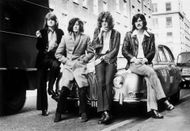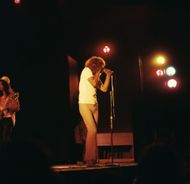Led Zeppelin formed in the late 1960s and soon became one of the most powerful forces in rock music. Hailed for their blend of blues, hard rock, and folk elements, the group produced a raw yet experimental sound that broke ground with each release. Their album list, albeit recorded in just over a decade, features tracks that are anthems, strong, long-lasting, and continually rediscovered by new generations.
Aside from the sound, their iconic stage performances and larger-than-life personas further cemented their status as icons. Years later, Led Zeppelin's impact continues to be part of the rock fabric, with their legacy persistently inspiring artists and drawing fans globally.
Few acts have made an indelible mark on the landscape of rock music like Led Zeppelin. They emerged in the late 1960s and didn’t just play at the boundaries of blues, rock, and folk—they burst through them, hammering out a deafening, genre-defying sound, defining a new generation of music.
Rather than following fashions, Led Zeppelin created them, combining raw acoustic sounds with fiery guitar riffs and powerful, driving drumming, both primal and ahead of their time. Their dominion, even though lasting only a decade, was a tornado of imagination, savagery, and sheer musical force.

Though the group was dissolved after the heartbreaking loss in 1980 of drummer John Bonham, the group's influence and legacy grew over the years. From vinyl records to streaming platforms, their songs are still being discovered by new generations, proof of just how well their music stands the test of time and of the myth that still lingers around their name.
The majority of Led Zeppelin's lasting legacy lies in their recording work, which pushed new sounds with each album. Led Zeppelin IV and Physical Graffiti are cases in point of how much the band was able to move between 'beating' rock standards and intricate acoustic ballads without sacrificing a distinct musical identity.
Jimmy Page's deft guitar playing, Robert Plant's commanding voice, John Paul Jones's ability on a multitude of instruments, and John Bonham's pounding drumming came together in a chemistry that was created but unforced. Their refusal to release singles in the UK and limited media coverage merely served to enhance their mystique, concentrating all attention on the album format.
This approach not only legitimized them as artists but also shifted how rock music was consumed and appreciated.
Disclaimer: This article contains the writer's opinion. The reader's discretion is advised!
Here are the top 8 Led Zeppelin songs of all time
Selecting the best eight Led Zeppelin tracks is not simply about chart performance or popularity items, it's about identifying the band's identity as it consistently changed yet remained unmistakably themselves. These tracks mark transitional points in their creative evolution, from tight, riff-based strength through melodic haze and atmospheric narration to genre-bending exploration.
Some songs became radio staples of classic rock; others attained legendary status via live shows and obscure cuts loved by loyal fans. What ties them together is how each song demonstrates Zeppelin's unapologetic style of music, testing boundaries, accepting contrast, and cementing their indelible stamp on the DNA of rock.
1) Stairway to Heaven
Stairway to Heaven is a career highlight for Led Zeppelin, a song that embodies their untitled fourth album's wonder, optimism, and conceit. Instead of bursting into full-tilt power, it prefers to build gradually, unfolding into a delicately played acoustic introduction which insidiously overflows into an epic tidal wave of electric might.
This stylistic development is an indication of how well the band could integrate styles so harmoniously, introducing folk, hard rock, and progressive influences into an interrelated system. The song was recorded in London and mixed in Los Angeles, with Jimmy Page’s meticulous production bringing out the band’s full synergy.
Robert Plant sings lyrics of a quest at once mythic and personal and filled with imagery resistant to analysis. "There's a lady who's sure all that glitters is gold," these lyrics evoke illusions and religious doubt, and they do share the atmosphere of old myths.
As the song builds, John Paul Jones's ambient keyboards and John Bonham's thundering drums chart its emotional trajectory, crashing toward Page's mystical guitar solo, a climactic moment now one of the rock era's most iconic. A song so beloved that it transcends mere fan favorite status, Stairway to Heaven is an affirmation of Led Zeppelin's musical intelligence and lasting strength.
2) The Ocean – Houses Of The Holy
Concluding the Houses of the Holy album, The Ocean displays Led Zeppelin's good-natured inventiveness and technical expertise. Taped in 1972 at Stargroves and Headley Grange with Jimmy Page at the helm as producer, the title is a reference to Robert Plant's affectionate term for their immense following. The song is a tribute to their fans, blending gritty blues components with inventive rock material.

It begins with John Bonham's legendary count-in, proceeds into a riff-driven groove by Page and rhythmic bass by John Paul Jones. Personal touches in Plant's lyrics are given as examples of episodes, such as taking care of his daughter while composing. The high-energy chorus captures the band's live performance intensity, and the unplanned doo-wop ending exhibits their ability to merge all kinds of styles in perfect harmony.
Read More: 10 Dido songs that deserve a spot on your chill playlist
3) Whole Lotta Love (Led Zeppelin II)
Whole Lotta Love begins with an awe-inspiring riff that bombards the listener with immediate energy, one of the finest rock songs of 1969. Recorded live on tour with Led Zeppelin, the track is a marriage of dirty blues and refined studio techniques in the hands of Jimmy Page.
Robert Plant's forceful vocals are complemented by John Bonham's bone-cracking drums and John Paul Jones's driving bass in an unglam but high-gloss sound. The experimental middle section pays homage to the band’s willingness to push artistic boundaries.
Chart achievement and commercial achievement solidified Led Zeppelin's place in rock's history books as pioneers of whatever is the next big thing.
Read More: 6 songs that showcase Addison Rae's pop star glow-up
4) Good Times Bad Times (Led Zeppelin)
Led Zeppelin's Good Times Bad Times is an incendiary opener, declaring the band's potential to revolutionize rock music in a flash. Recorded late in 1968 at London's Olympic Studios with Jimmy Page at the production controls. The tune utilizes the talents of the original four members: screaming vocals from Robert Plant, insane guitar work by Page, John Paul Jones on bass, and John Bonham's innovative drum work.
While not issued as a number-one hit single, the song produced the band's usual blend of hard rock intensity, blues heritage, and record studio artistry. The song's lyrics explore personal growth and life's ups and downs, creating a storyline that includes swaggering braggadocio with questioning vulnerability.

The poetic specificity, like the musing on what exactly one is conditioned at an early age to be a man, and the repeated refrain of having revelations about life's peaks and valleys, is very descriptive.
The music thrives on the interplay between Page's unmatchable layered guitar harmonies and Bonham's characteristic triplet drumming, something which testifies to their stupendously high level of musicianship and the band's early creative partnership chemistry.
Read More: 8 legendary music samples and their surprising origins
5) The Rain Song (Houses Of The Holy)
The Rain Song, the crowning glory of Houses of the Holy, shows Led Zeppelin to have a wealth of ability in combining emotional sensitivity and musical subtlety, rising above their characteristic rock music to a level of orchestral sophistication.
Jimmy Page and Robert Plant wrote the song, which was recorded at Stargroves and cut well at Olympic Studios by Page's fastidious production, the resultant being a richly textured setting of delicacy and technical command.

It opens with Page's double-neck Gibson guitar alternate tuning, an introspective mood hovering over the features of an unstable storm. Mellotron strings inject warmth from John Paul Jones, providing a cinematic feel, and John Bonham's subdued drumming creates an understated, heartbeat-like beat that keeps the piece grounded.
Plant's emotive vocals question love, resurrection, and the rise and fall of feeling in structuring poetic lyrics like "These are the seasons of emotion, and like the wind, they rise and fall."
In its mournful build and lyrical reflection, The Rain Song leads the listener into profound consideration of the rise and fall of human relationships, playing out Led Zeppelin's craftsmanship as it breaks out of the set rock conventions.
Read More: 8 Ice Cube songs that show why he’s a legend
6) No Quarter (Houses Of The Holy)
No Quarter, a gem of Led Zeppelin on Houses of the Holy, transports the listener to an otherworldly and ominous setting that's contrary to the hard rock anthems of the band. Having been cut in the atmospheric studios at Stargroves and Headley Grange, where Jimmy Page's aggressive production was dominant, the song is the perfect evidence of the band's experimental and progressive way.
It is about John Paul Jones's mesmerizing piano work, on electric Wurlitzer piano overdubbed with pitch effects, to create a chill sound space. Over the top are placed Jimmy Page's tightly wound but held-in guitar lines and John Bonham's hard-hitting but held-in drumming to build a tension that drives the song onward.
Robert Plant's soothing, semi-psychic vocals coax one's ear into enigmatic words regarding war tales of troopers holding firm against savage armies: "The winds of Thor are blowing cold / They're wearing steel that's bright and true."
No Quarter stands out in that it is a more sinister tale of survival through sacrifice. Its somber mood and sound journey have elicited high praise from fans and critics alike, and it's a seamless addition to the Led Zeppelin catalog, a risk to venture into the black space of their work.
Read More: 10 famous songs you didn’t know were originally written for someone else
7) Trampled Under Foot (Physical Graffiti)
Trampled Under Foot from the album Physical Graffiti is breakneck funk-rock fusion that attests to the eclecticism of Led Zeppelin in splicing heavy sound and high-energy groove. The song was recorded in 1974 at Headley Grange using The Rolling Stones Mobile Studio and produced by Jimmy Page, and is famous for rhythmic experimentation.

Its highlight is John Paul Jones's Clavinet mastery on "B-Flat Baby," the instrumental lending the song a stinging, syncopated funk that makes the song a driving, adrenaline-fueled beat that powers the album's sprawling double-disc.
Robert Plant's words, of course, blend blues-inspired car imagery and sheer s*xuality, but "Grease me and slide me, just don't try to hide me" are the entreaties of a savage assault on the stubbornly recalcitrant life of the music.
Plant's singing is a charm and strength, shifting between acid seduction and rhythmic violence, offering a funkier, more danceable option to the band's hard rock attack, the signature sound.
Read More: 8 Tate McRae songs you need on repeat
8) Kashmir (Physical Graffiti)
Emerging as one of Led Zeppelin's most ambitious and enduring works, Kashmir from the album Physical Graffiti maintains a deep mix of musical and spiritual complexity. It took several years to craft and finish. Completed in 1974, the song was written at Headley Grange with further developments done at Olympic Studios in London.
With Jimmy Page's virtuosic production, the song combines intricate guitar themes, John Bonham's powerful drums, and John Paul Jones's stately string arrangements, all framed by Robert Plant's resonant vocals. Born out of a trip to Morocco but named for the Himalayas, Kashmir transcends geography in its suggestion of a spiritual quest.
Its lyrics invite listeners into an inner quest, balancing raw terrestrial power with celestial yearning. This mixing of relentless rhythm and poetic vision lifts the song to the same heroic plane as Stairway to Heaven, offering a common reflection upon entry and overcoming.
Read More: Top 8 Notorious B.I.G. tracks you can't forget
Together, Led Zeppelin is a giant in rock music, with raw energy allied to musical intelligence in a bizarre gamut of styles. From the blues-guitar chord work of their early records to the majesty of Kashmir and Stairway to Heaven, the group never stopped pushing creativity.
Their backgrounds convey a deep regard for broad-reaching influences, blues, folk, Eastern sounds, hard rock, bleached into both new-sounding and unmistakably their own. In a span of eight studio albums, Led Zeppelin redefined the parameters of rock music, an artistic legacy of forever great songs, technical mastery, and enduring mystique that will remain to enthrall generations of fans.
Keep reading SoapCentral for more informative content!
Also Read: 6 times Juliette Binoche owned the Cannes red carpet
